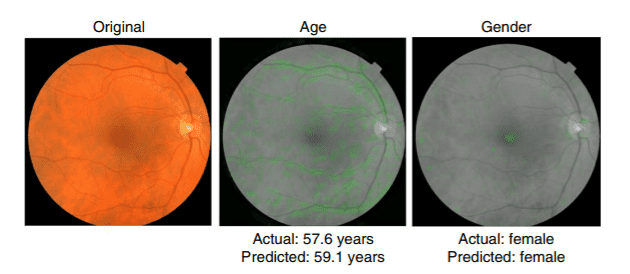Google researchers are extremely intuitive: just by looking into people’s eyes they can see their problems — cardiovascular problems, to be precise. The scientists trained artificial intelligence (AI) to predict cardiovascular hazards, such as strokes, based on the analysis of retina shots.

After analyzing data from over a quarter million patients, the neural network can predict the patient’s age (within a 4-year range), gender, smoking status, blood pressure, body mass index, and risk of cardiovascular disease.
“Cardiovascular disease is the leading cause of death globally. There’s a strong body of research that helps us understand what puts people at risk: Daily behaviors including exercise and diet in combination with genetic factors, age, ethnicity, and biological sex all contribute. However, we don’t precisely know in a particular individual how these factors add up, so in some patients, we may perform sophisticated tests … to help better stratify an individual’s risk for having a cardiovascular event such as a heart attack or stroke”, declared study co-author Dr. Michael McConnell, a medical researcher at Verily.
Even though you might think that the number of patients the AI was trained on is large, AI networks typically work with much larger sample sizes. In order for neural networks to be more accurate in their predictions, they must analyze as much data as possible. The results of this study show that, until now, the predictions made by AI cannot outperform specialized medical diagnostic methods, such as blood tests.
“The caveat to this is that it’s early, (and) we trained this on a small data set,” says Google’s Lily Peng, a doctor and lead researcher on the project. “We think that the accuracy of this prediction will go up a little bit more as we kind of get more comprehensive data. Discovering that we could do this is a good first step. But we need to validate.”
The deep learning applied to photos of the retina and medical data works like this: the network is presented with the patient’s retinal shot, and then with some medical data, such as age, and blood pressure. After seeing hundreds of thousands of these kinds of images, the machine will start to see patterns correlated with the medical data inserted. So, for example, if most patients that have high blood pressure have more enlarged retinal vessels, the pattern will be learned and then applied when presented just the retinal shot of a prospective patient. The algorithms correctly discovered patients who had great cardiovascular risks within a 5-year window 70 percent of the time.
“In summary, we have provided evidence that deep learning may uncover additional signals in retinal images that will allow for better cardiovascular risk stratification. In particular, they could enable cardiovascular assessment at the population level by leveraging the existing infrastructure used to screen for diabetic eye disease. Our work also suggests avenues of future research into the source of these associations, and whether they can be used to better understand and prevent cardiovascular disease,” conclude the authors of the study.
The paper, published in the journal Nature Biomedical Engineering, is truly remarkable. In the future, doctors will be able to screen for the number one killer worldwide much more easily, and they will be doing it without causing us any physical discomfort. Imagine that!






